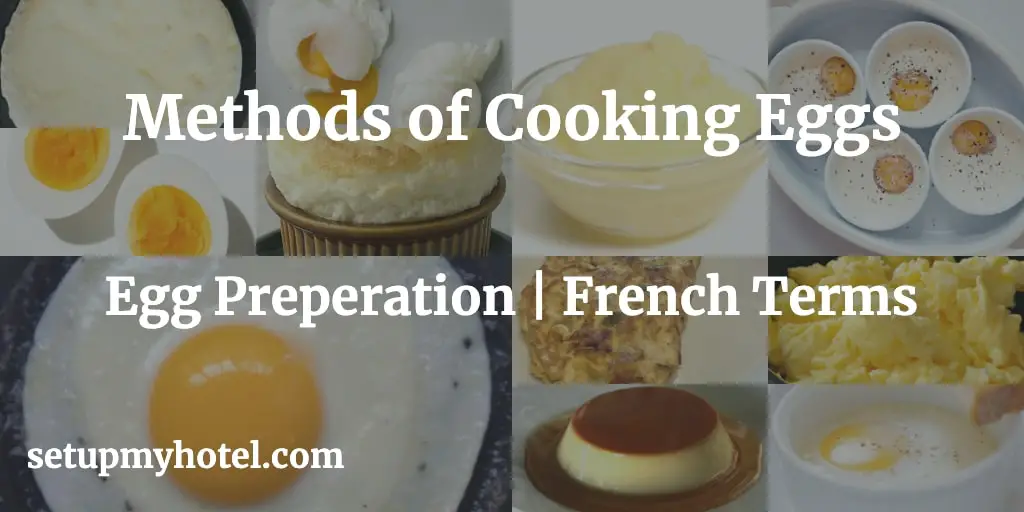Different Methods of Cooking Eggs in Hotel Kitchen
1.BOILED EGG (Oeufs Bouillis)
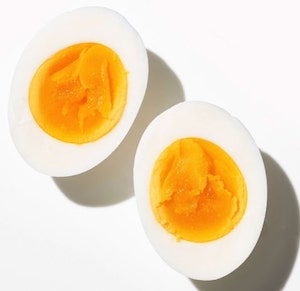
Boiled eggs are one of the most widely used types of cooked eggs. This use, however, is not always at the breakfast meal. The hard-boiled egg is used as an ingredient in many dishes and as a garnish for many dishes. Both soft-boiled and hard-boiled eggs are popular breakfast items.
While preparing boiled egg there are only two important things to be kept in mind. 1) The cooking time, will be determined by the consistency of the white and yolk. 2) Is the water temperature?
Method to Prepare Boiled Eggs:
- Select only those eggs which are free of cracks, The eggs which have cracks will seep during the cooking process and will not be suitable for service.
- Bring a quantity of water sufficient to cover the eggs completely, to a rapid boil.
- Carefully lower the eggs into the water and reduce to a simmer 82 to 85 °C (180°F – 185°F).
- Cook for 3-8 minutes for soft-boiled eggs and 10 minutes for hard-boiled eggs.
- The egg should be plunged into the simmering liquid, reboil, and simmer for the required time.
- Commence timing once the water has reboiled.
The three stages of boiling eggs are:
Soft Boiled (in the shell) [Oeuf a la Coque] – boiling time 3 to 4 minutes.
Soft Boiled (without shell) [Oeuf Mollet] – boiling time 5 minutes.
Hard Boiled [Oeuf Dur] – boiling time 8 to 10 minutes served with or without the shell.
2.SCRAMBLED EGGS (Ouefs Broilles)
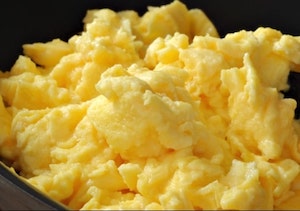
Scrambled eggs are another popular breakfast item. They can be prepared with or without the addition of milk, depending on the preference of the chef and the guest, and finished with butter or cream.
In France, good scrambled eggs are considered an art; gently stirred over low heat to a thick creamy puree which is elegantly garnished with truffles, smoked salmon, or chopped chives. These are prepared by thoroughly mixing the eggs, seasoning with salt and pepper, adding them to a little butter melted in a thick-bottomed pan, then cooking slowly stirring with a wooden spoon until set.
To hold scrambled eggs on a buffet add one tablespoon of water, milk, or cream to one egg( one cup 16 eggs). They are then cooked to a soft stage and then held between 54° and 60°C ( 130- 140°F). 54 C (130°f) is the lowest temperature one can use without encouraging bacteria growth.
Slightly overheating will cause the liquid to squeeze out and form a separate puddle. It can be recognized when the liquid collects around the edge of; for example custard or a mould of gelatine products and is termed as SYNERISIS (weeping).
Scrambled eggs may be served in many ways, for example on anchovy toast, with cooked diced sweetbreads, with diced cooked ham or bacon, etc.
Method To Prepare Scrambled Eggs:
- BeatBeat / Beating is a method to move a whip or spoon rapidly back and forth to blend products together... the desired number of eggs until well blended.
- If milk is used, the normal proportion is 1/2 cup for 6 eggs.
- The milk is to be added when the eggs are beaten.
- Heat a saute or frying pan and add fat.
- When fat bubbles, pour your beaten egg into the pan.
- The Fast should be hot, but not excessively so or the egg will frizzle.
- Shake the pan while stirring the eggs.
- There should be no egg white showing, and the eggs should be cooked to a creamy consistency.
- The longer you cook the scrambled egg the tougher it will become.
- It is best to remove it from the heat slightly undercooked, allowing the carry-over heat to finish setting the egg.
3.POACHED EGGS (Oeufs Pouches)
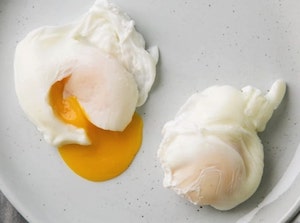
PoachedPoached - Cooked in enough simmering liquid to cover the food. eggs are used in a variety of ways in breakfast service. One difficulty of this preparation method is keeping the form of the egg in the cooking process. Only the freshest eggs should be used while poaching eggs.
The whites will remain more closely gathered around the yolk and not spread out in thin wisps. The yolk in the cooked egg should also remain soft and tender.
POACHING EGG IN BAIN-MARIE ( OEUFS MOULES ): A cooking vessel with a lid is half filled with water to form a bain-marie. Bring the water to boiling point. Prepare the egg molds with seasonings and a knob of butter to flavor and prevent eggs from sticking to the molds. BreakBreak�is the point in the laundry wash cycle at which a high-alkaline; soil loosening product is a... the egg into individual molds and place in the bain-marie with the lid on for gentle cooking. Cook for 3-5 minutes so that the white sets and the yolk remains soft. Turn out and serve hot.
Method of Poaching Eggs:
- Put sufficient water in a pan of suitable size.
- To poach eggs, fill a deep pan with about two and a half inches of water.
- Add one tablespoon of salt and one tablespoon of vinegar per gallon of water.
- The vinegar, an acid, helps to set the egg white and prevents it from spreading.
- Acid also makes the eggs more tender and, the whites whiter.
- The poached egg must be fresh or it will spread even though vinegar is used.
- Both salt and vinegar help to coagulate the egg as soon as it enters the poaching liquid so that it retains a better shape.
- Then cook the eggs until the desired degree of doneness is reached.
- Carefully remove from the water with a slotted spoon.
4. CODDLED EGGS (OUFS À Codes)
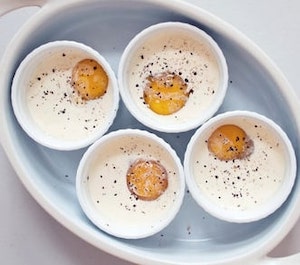
Eggs are coddled in the shell or coddler. They are cooked by pouring boiling water over the edges, and one pint of boiling water over an egg. The eggs are then covered and held in a warm place until cooked (six to ten minutes) for firm yokes and pleasantly soft whites.
Method to Prepare Coddled Egg:
- SetSet: Allowing an item to go from a soft or liquid state to a firmer more solid state. the coddler inside a medium saucepan and fill it with water to come three-quarters up the side of the coddler.
- Remove the coddler and bring water to a gentle boil over medium heat and then butter the coddler.
- Pour in half of the cream and add half of ham and chives; season with salt and pepper.
- Add egg, then top with remaining cream, ham, chives, etc.
- Season with salt and pepper and seal closed.
- Place the coddler in water and cook the egg for about 8 minutes until the whites are set but the yolk is still runny.
5. EN COCOTTE (Oeufs en CocotteEarthenware or metal vessel with a lid. used for cooking and serving. usually oval or round in shape...) / Shirred Eggs:
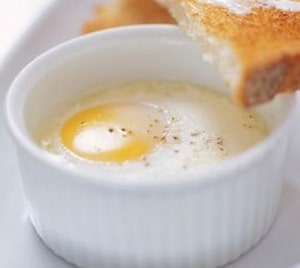
Similar to poaching except that eggs are poached in porcelain dishes (cocotte). The dishes are buttered, the eggs placed in them and both placed in Bain-Marie for about 2 to 3 min. This dish is served for lunch or dinner and is presented in and eaten from the cocotte dish in which it is cooked.
Method to prepare Egg EN COCOTTE (Oeufs en Cocotte):
- Butter small bowls and season with a pinch of salt and pepper.
- Pour a scant tablespoon of cream into each bowl and set aside.
- Heat olive oil in a small saute pan over medium-high heat and add in chanterelles, thyme and sage.
- Cook until chanterelles are tender, about 3-5 minutes.
- Pour the mixture into the bowls and crack one egg on top of each bowl.
- Place bowls in a baking dish, and pour water into the baking dish until it is halfway up the sides of the bowl.
- Transfer the baking dish to the oven, being careful not to let the water splash into the bowls.
- BakeBake / Baking - To cook food by surrounding it with hot dry air. similar to roasting; the term bakin... at 375° F (190 °C) for 10-15 minutes or until whites are set and the yolk is still soft.
6. FRIED EGG (Oeufs Frits):
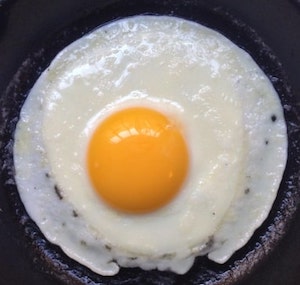
Fried eggs top the list of breakfast orders. There are four types of fried eggs: Over Easy, Hard fried, basted, and sunny side up. The preparation of each of the four types begins in the same manner, but the steps for finishing them are different.
The preparation of any type of fried egg requires close attention to the amount of heat used. Too high heat cooks the egg too quickly, toughening the bottom and leaving the yolk cold. The temperature should be sufficient to allow the egg to cook to the desired degree of doneness without being toughened, yeat heating the white and yolk thoroughly.
The fried egg is the centerpiece of the great British breakfast, surrounded by bacon, sausage, tomatoes, mushrooms, baked beans, black pudding, and toasted bread. Eggs done or cooked only on one side are known as SUNNY SIDE UP. For EASY OVER use a palette knife to flip each egg carefully.
Method to Prepare Different Types of Fried Eggs:
- Heat a saute or frying pan and then add the fat, clarified butter, bacon fat, shortening oil, etc.
- When the fat bubbles, slip the eggs into the pan, it is best if the eggs are cracked open into a dish before being placed in the pan.
Fried Egg – Over Easy:
1) Cook the egg until the white is set.
2) Flip the egg by pushing the pan forward and then pulling it back sharply.
3) The curvature of the egg pan should allow the egg to flip over.
4) Continue to cook until the white is firmly set but the yolk is still soft.
Fried Egg – Hard Fried:
1) Cook the egg until the white is set.
2) Puncture the yolk of the egg, then flip in the same manner as that for over-easy.
3) Continue to cook until both the white and yolk are firmly set.
Fried Egg – Baster:
1) Do not flip, BasteBaste - To pour dripping or other fat over a food before or during cooking in order to prevent dryin... the yolk of the egg with hot fat or cover the pan and allow the egg to steam slightly.
2) In either case, the egg yolk is slightly whitened.
3) The egg is cooked until the white is firmly set and the egg yolk is thoroughly heated but soft.
Fried Egg – Sunny Side Up:
1) Cook the egg, without flipping or basting.
2) Wait until the white is set firmly and the yolk is thoroughly heated but soft.
7. OMELETTES (Les Omelette):
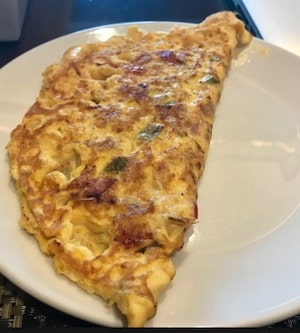
Like fried eggs, omelets have been and continue to be a popular breakfast item and are present always on the breakfast menu. The versatility of this dish makes it a highly desirable menu item. In reality, the basic omelet is nothing more than scrambled eggs enclosed in a coating of coagulated egg.
Omelette can be served plain or filled with many items like bacon, cheese, onion, chilly, sausages, seafood, spinach, seafood, herbs, asparagus, etc. There are a variety of types of omelets like rolled, folded, in half, thirds, left flat or puffed, etc. depending on the guests the omelet is finished by the Breakfast Chef.
Method to prepare Omelette:
- Begin as you would for scrambled egg, but as the egg set up stop stirring and shake the pan.
- It is necessary to let the eggs set, but not stick to the pan.
- When the eggs are just at the soft runny stage start adding your filler.
- At this point, the omelet may be rolled, or folded in half or thirds depending on the guest’s request or preference.
Other ways of adding garnishes or flavorings are the following:
- Combined with egg before cooking.
- Placed into the center of the omelet before it is folded.
- Placed on top of the omelette, in a cavity after folding is complete.
Examples of Special Omelette Preparation:
The Omelette Parmentier is served American style folded. SauteedSauteed - Browned in a small amount of oil or fat. �, diced potato, and chopped parsley are added just at the point of egg setting and then the omelet is folded and served hot.
The Souffle Omelette is prepared by keeping the white and yolk of the egg separately. The white is whipped separately to the consistency of whipped cream The egg yolks are then beaten and the whites are folded into them. The Mixture is poured into a pan which is hot and lubricated and cooked until the bottom is set and slightly brown. The egg pan is then placed on to the oven or salamander to finish.
8. SOUFFLES (soufflé):
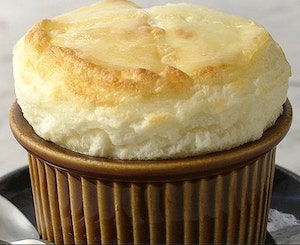
Soufflés are similar to puffy or foamy omelets except that they have been thickened with flour, butter, and milk. The proportion of an egg is lower than in an omelet. To make a soufflé the eggs are separated and added to the white sauce or starch thickened mixture.
The whites are beaten to soft foam before being folded into the rest of the materials. Soufflés are baked at 149 C (300 F) and they should be served soon after they are cooked.
Method to Prepare Vanilla soufflé:
- Butter soufflé mold and toss them with caster sugar.
- Beat the whites by gradually adding sugar.
- Relax the custard cream in a saucepan on the fire.
- Once the whites have risen with the sugar, stir in the custard cream.
- GarnishGarnish - The artistic complementing of a food item with other food or edible item. the soufflé mold, smooth it with a spatula, and go around the mold at the knifepoint.
- At the moment put a soufflé on a hot plate in a hot oven at 180 ° c. Cook for 9 minutes.
9. CUSTARDS (Crème aux Oeufs):
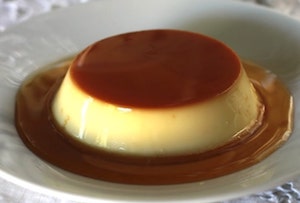
True custards contain only milk, eggs, sugar, and flavoring. No starch agent is added. Baked custards must contain enough eggs to produce a firm mass. Custards should be cooked in a container of water to prevent overheating. For firm Custard heats the milk to about 66 C (150 F) then adds this to the mixture of sugar, eggs, and flavoring.
An oven temperature of about 177 C (350 F) is used for baking custards, but if the temperature of the custard itself exceeds 85 C (185 F) the custard is likely to contain holes, be watery and have a concave top. Once the custard is cooked it should be placed in a cool spot for setting in a pan of cold water. At a very high temperature synergetic occurs this is a separation of liquid from the gel, caused by contraction of the proteins.
10. PUDDINGS AND CREAMS:
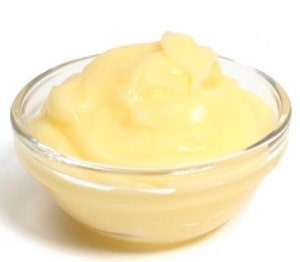
A thickened mixture of corn flour, milk, sugar, and flavoring is called a blancmange or corn flour pudding. If eggs are added to this mixture, the pudding is called a cream pudding.
Preparing Bavarian Creams (Bavarois): Add corn flour or cream puddings made with light gelatine, whipped cream, beaten eggs, and other ingredients for Bavarian creams. Add 1/4 tsp creams of tartar are added for each 5 egg whites.
ZabaglioneEggs; sugar and wine whisked until thick; for serving as a sweet dish. or Sabayon: is a dessert of Italian origin made with egg yolks, sugar, and wine (Marsala).
Quiches: These are custards baked in a pastry case. It contains eggs, milk, cheese, bacon, and onions.
11. OTHER EGG ITEMS:

Crepes are thin pancakes made from flour, sugar, milk, and eggs. No baking powder is added to them as in American-style pancakes. Crepes are popular as desserts or as entrees. After mixing the pancake batter, it must be allowed to rest in the refrigerator for half an hour. Fondues contain eggs especially that of Geneva, which is made up of egg yolks and cheese.
Some fondues are baked custards containing parts of bread, loosely resembling a soufflé. Cheese fondues probably originated in Switzerland. Swiss cheese is melted in white wine. The wooden or earthenware bowl in which it is served is rubbed with garlic and kirsch or cherry brandy just before the fondue is served. It is then picked up on chunks of bread for eating.
Eggs are also basic to many baked desserts, including all those using sweet dough, puff paste, sponge, or genoise. They are also used in mousses.
